Roman nightlife was a vibrant and essential part of ancient Rome’s social fabric. After the sun set, the city transformed into a lively scene where citizens and travelers converged to unwind, socialize, and seek entertainment. The Roman Nightlife: Taverns, Gambling, and Urban Legends After Dark created a distinctive atmosphere that reflected the diversity and energy of urban life.
Key elements defining this nocturnal culture included:
- Taverns: Central hubs for food, drink, and social interaction.
- Gambling: Popular pastime that added excitement and risk.
- Urban Legends: Stories of ghosts and mysterious happenings that deepened the city’s allure after dark.
These components combined to form a dynamic social scene after dark, showcasing a unique side of ancient Rome rarely seen in daylight.
Taverns: The Heart of Roman Nightlife
Roman taverns were the center of social life after dark, bustling with activity and serving as gathering places for citizens from all walks of life. These establishments had different purposes and attracted various types of customers, each offering a one-of-a-kind experience that reflected the diversity of urban Rome.
Types of Taverns and Their Characteristics
Understanding the differences between tabernae, popinae, cauponae, and thermopolia helps us understand how rich and varied Roman nightlife was.
1. Tabernae
These were versatile shops or stalls often located along busy streets or within markets. While primarily commercial spaces selling goods, some tabernae doubled as places to grab a quick drink. They lacked seating arrangements typical of dedicated taverns but attracted passersby needing refreshment or small meals. Tabernae connected everyday commerce with casual socializing.
2. Popinae
Known as wine bars, popinae specialized in serving wine accompanied by simple dishes like olives, cheese, or salted fish. Unlike tabernae, popinae offered space for customers to sit and linger, creating a more relaxed atmosphere conducive to conversation and drinking. Popinae drew a mixed crowd but were particularly popular among lower classes and those seeking affordable entertainment.
3. Cauponae
Functioning as inns, cauponae catered especially to travelers and merchants visiting Rome. They provided lodging alongside food and drink—a critical service in the sprawling urban environment where visitors needed rest after long journeys. Cauponae often had private rooms, distinguishing them from other tavern types focused mainly on daytime trade or evening leisure. However, their reputation sometimes skewed negative due to associations with rowdiness or illicit activities.
4. Thermopolia
Comparable to modern fast-food counters, thermopolia served hot ready-to-eat meals quickly to customers on the go. These establishments featured counters with embedded jars (dolia) holding prepared foods such as stews, pulses, or bread—ideal for those unable to cook at home or preferring convenience after dark. Thermopolia were widespread across Rome’s neighborhoods, providing nourishment without requiring patrons to stay long.
| Tavern Type | Primary Function | Clientele | Setting & Ambiance |
|---|---|---|---|
| Tabernae | Shops selling goods/drinks | Shoppers, casual passersby | Minimal seating; transactional |
| Popinae | Wine bars | Lower classes; locals | Seating available; socializing |
| Cauponae | Inns with food & lodging | Travelers; merchants | Private rooms; more formal |
| Thermopolia | Fast food counters | Working class; busy urbanites | Quick service; standing room |
The variety in these venues illustrates how Roman nightlife accommodated different needs—from quick refreshment to all-night hospitality.
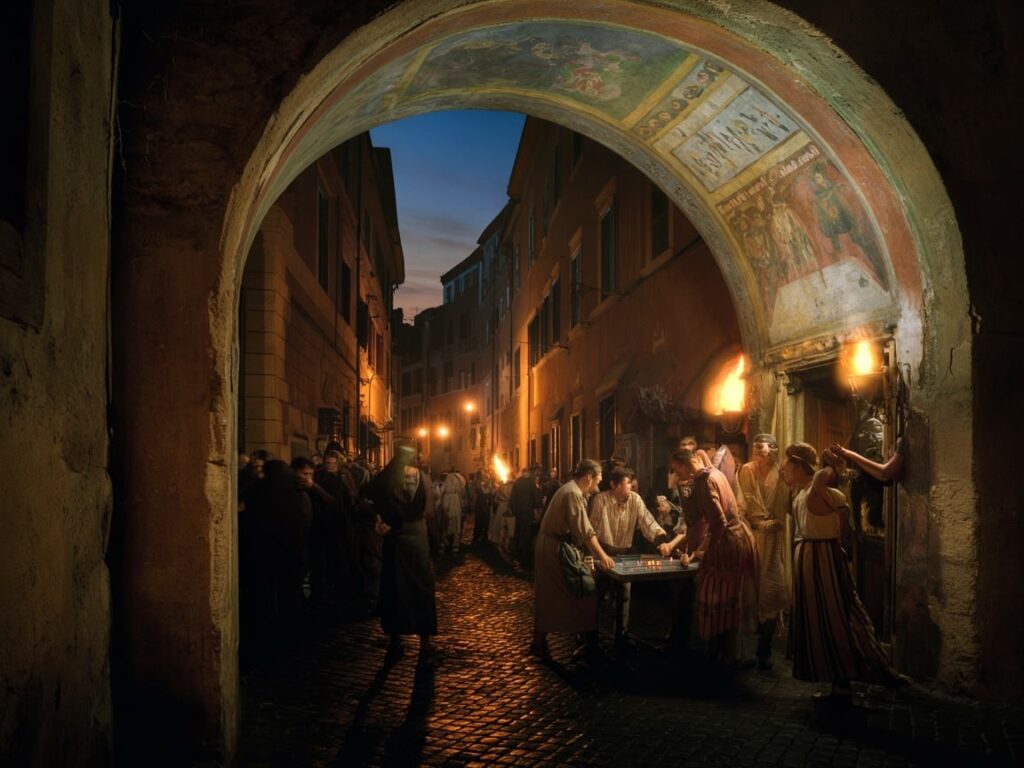
Social Dynamics within Taverns
Roman taverns were melting pots where social boundaries blurred under the ambiance of wine and warmth. Poorer citizens mingled freely with itinerant traders or sailors who sought respite from the city streets. Conversations ranged from politics to gossip while musicians or entertainers occasionally enlivened the environment.
In popinae and thermopolia especially, the atmosphere encouraged interaction across social strata that formal settings rarely allowed.
Social Dynamics within Taverns
Roman taverns were more than just places to eat and drink; they served as vibrant social hubs where different strata of society converged. The diverse clientele of tabernae, popinae, cauponae, and thermopolia reflects the complex social fabric of ancient Rome.
1. Poorest Citizens
These establishments offered affordable food and drink options, making them accessible to the lower classes. Poorer Romans often gathered here not only for sustenance but also for companionship and a break from daily hardships.
2. Travelers and Merchants
Cauponae, functioning as inns, catered primarily to travelers needing lodging and refreshment. These visitors brought news and stories from other parts of the empire, enriching the tavern atmosphere with a sense of connection beyond the city walls.
3. Local Workers and Artisans
Popinae attracted local laborers seeking relaxation after long workdays. The lively atmosphere in these wine bars included music, conversation, and sometimes rowdy behavior, reflecting the energetic pulse of Roman nightlife.
Interactions between these groups created a dynamic environment marked by:
- Cross-Class Exchanges: While social hierarchies remained significant in Roman society, taverns provided spaces where distinctions blurred temporarily through shared activities like drinking or gambling.
- Entertainment and Storytelling: Music, games, and animated discussions fueled nightly gatherings. The presence of entertainers or storytellers added layers to the social experience.
The distinctions among types of taverns defined their roles but did not limit the mingling of patrons. This blend contributed to a rich cultural tapestry that characterized Roman nightlife: a space where social barriers lessened amid food, drink, risk-taking, and communal lore.
Furthermore, the art scene during this period was also significantly influenced by the social dynamics within these taverns. The Evolution of Roman Sculpture, which captured realism and power, often found its subjects among the very people who frequented these establishments. This art form evolved significantly over time, showcasing a distinct focus on realism and the portrayal of power. The sculptures served not only as artistic expressions but also as instruments for political propaganda and religious devotion.
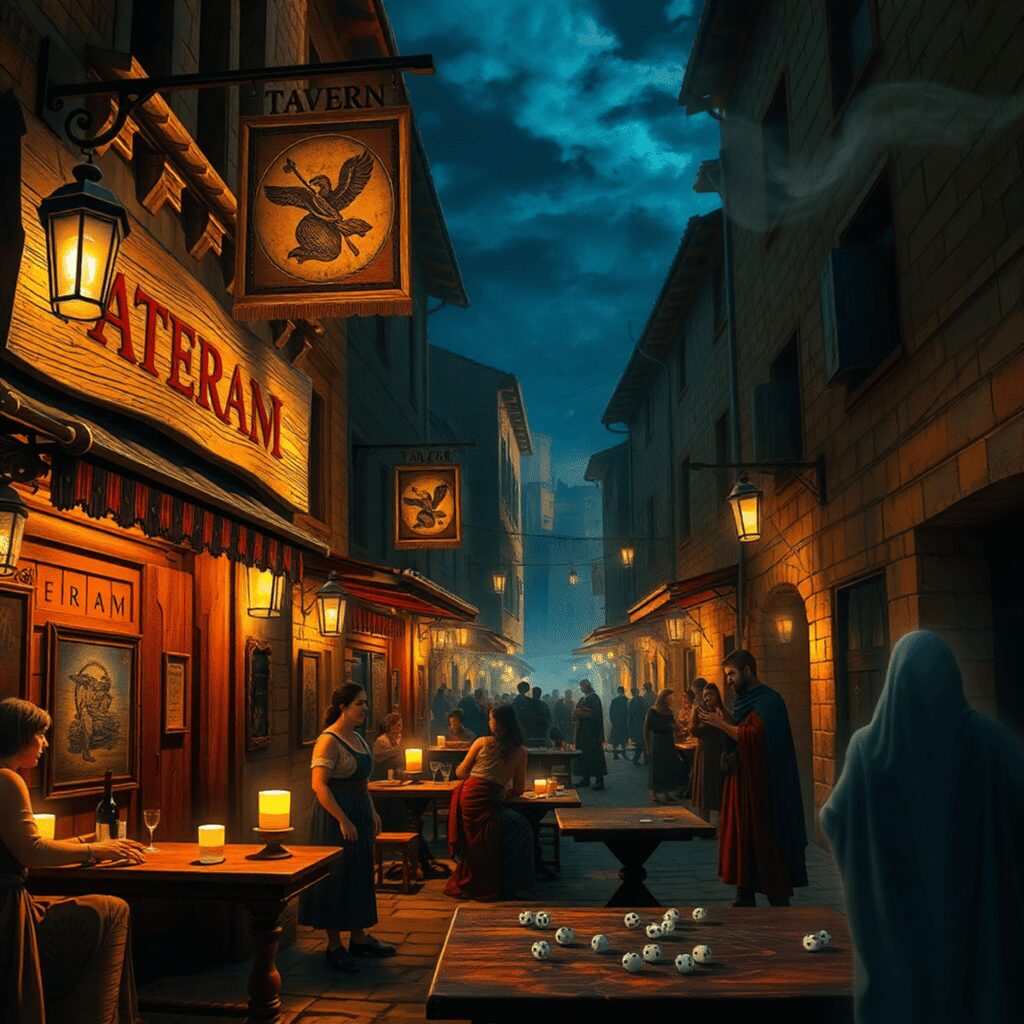
Gambling in Roman Nightlife
Gambling was an integral part of Roman nightlife, especially in the bustling taverns that filled the city. At night, these establishments became centers of risk and chance, where Romans from all walks of life came together not just to drink and socialize but also to try their luck.
Popularity and Prevalence of Gambling in Taverns
Despite official efforts to regulate or limit them, Roman gambling activities were widespread and generally accepted. The thrill and social interaction they provided were too appealing to resist. Gambling wasn’t just for the rich; it attracted a wide range of citizens including soldiers, merchants, laborers, and travelers. Taverns offered a convenient space for such activities—informal places where money could quickly change hands amidst lively conversations and clinking cups.
The popularity of gambling after dark contributed to a flourishing nighttime economy. It was common to see groups huddled over games on wooden tables or sitting directly on benches. This openness showed a cultural acceptance of games of chance as entertainment, even if excessive gambling sometimes faced social criticism or legal consequences.
Types of Gambling Games Commonly Played by Romans
Several types of ancient Roman games formed the core of gambling practices:
- Dice throwing (alea): The most iconic and widely played game involved tossing small dice made from bone or ivory. Alea was simple but thrilling, with bets placed on outcomes ranging from single die rolls to combinations.
- Board games: Variants similar to modern backgammon were popular among gamblers who enjoyed more strategic challenges alongside chance.
- Betting on gladiator fights or chariot races: Although not confined to taverns alone, wagering on public spectacles was an integral part of Roman betting culture.
- Knucklebones (tali): Using four-sided bone pieces thrown like dice, this game combined luck with skillful throws.
Gambling Practices and Cultural Implications
Roman gambling had both recreational and symbolic meanings. It showed a willingness among participants to accept uncertainty—an attitude that reflected broader societal values about fate and fortune. Betting customs often involved communal stakes where winners could claim prize money or goods while losers accepted their losses without shame.
“Let the dice decide,” was a common saying that captured how alea mirrored life’s unpredictability.
Despite its popularity, gambling also faced criticism from moralists who viewed it as a vice leading the poor to ruin or distracting them from civic duties. Laws sometimes imposed fines or bans on public gambling; however, enforcement proved inconsistent given its deep-rooted presence in daily life.
In taverns specifically, gambling created an atmosphere filled with tension and excitement. Players often cheered or groaned loudly as dice rolled across tables. This energy added another dimension to Roman nightlife—where socializing merged with competition and chance.
Interestingly, this embrace of uncertainty reflected broader societal values about fate and fortune in ancient Rome. Roman gambling activities demonstrate how entertainment after sunset wasn’t solely passive but required active involvement with risk—the roll of dice symbolizing both enjoyment and destiny in the vibrant urban scene of ancient Rome at night.
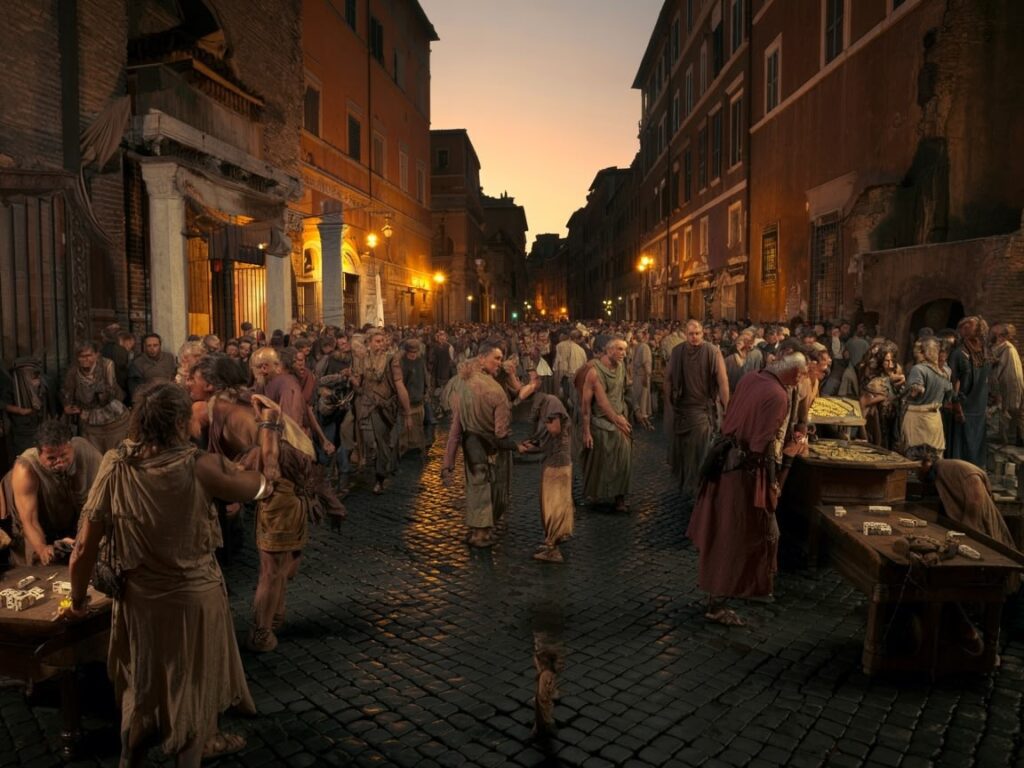
Urban Legends and Myths After Dark
Roman urban legends had a significant impact on the nighttime atmosphere of the city. In ancient Rome, night wasn’t just a time for hanging out and having fun; it was also when imagination and fear came together, fueled by stories passed from person to person. These legends helped create a one-of-a-kind vibe that made the city’s nightlife feel mysterious and suspenseful.
Role of Urban Legends in Shaping Nocturnal Atmosphere
Urban legends thrived in the dimly lit streets and bustling taverns where people gathered after dark. Romans shared tales of supernatural beings, haunted locations, and unexplained events that were said to occur once the sun had set. These stories often served as warnings or explanations for strange noises, sudden chills, or shadows seen fleetingly in alleyways.
Common themes included:
- Ghosts of restless spirits wandering near old temples or burial sites.
- Curses linked to disgraced nobles or criminals who met tragic ends.
- Apparitions appearing on certain nights to foretell doom or fortune.
Such tales heightened the senses of those enjoying Roman nightlife, adding an element of thrill alongside the more concrete pleasures of food, drink, and gambling.
Popular Myths Circulating Among Romans at Night
Several myths gained traction among Roman citizens due to their vivid storytelling appeal:
The Phantom Senator: A ghost reputed to appear in the Senate House after midnight, warning of political conspiracies and betrayals. This legend reflected societal anxieties about power struggles and political instability, which were prevalent during certain periods of Roman history.
The Weeping Woman of the Forum: Said to be the spirit of a woman who lost her family during civil unrest, her cries were believed to echo through Rome’s central square on moonless nights.
The Shadow Thief: Stories told of a mysterious figure who could steal a person’s shadow during late-night wanderings, causing misfortune or illness until rituals were performed to reclaim it.
These myths circulated freely in taverns where patrons exchanged not only drinks but also whispered secrets and chilling anecdotes that enhanced the nighttime experience.
Influence of Folklore on Nighttime Social Life
Folklore permeated every layer of Roman society after dusk. The sharing of urban legends became an informal social ritual in taverns and public spaces, binding communities together through common narratives. These stories:
- Encouraged cautious behavior in poorly lit areas.
- Provided entertainment that complemented gambling and drinking.
- Created shared cultural references that transcended class differences.
In taverns, storytellers or seasoned regulars often held captive audiences with their dramatic recounting of ghostly sightings or mysterious happenings. The mystique surrounding these tales added depth to Roman nightlife by blending reality with imagination.
The impact of Roman folklore extended beyond mere superstition; it influenced how people navigated their city once darkness fell. Fear mingled with fascination, making urban legends an inseparable part of nightly social interactions.
The presence of such stories ensured that Roman nightlife was not just about physical spaces like taverns or activities like gambling but also about an intangible atmosphere charged with mystery—an atmosphere that made each night unpredictable and memorable.
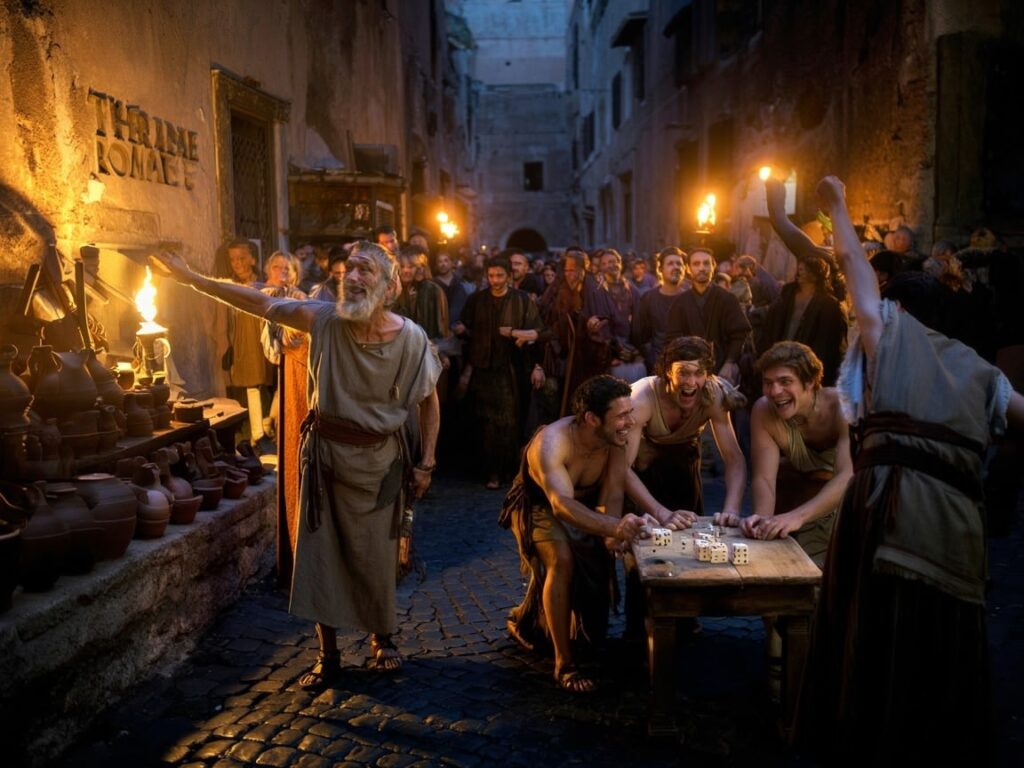
The Overall Experience of Roman Nightlife Culture
Roman nightlife culture thrived on a vibrant mix of activities that transformed the city once the sun set. The bustling taverns served as hubs for socializing, where people from various walks of life gathered to share stories, enjoy food and drink, and forge connections. Entertainment ranged from lively conversations to impromptu performances, creating an atmosphere charged with energy.
Risk-taking was an integral part of the scene, especially through gambling. Dice games and betting brought excitement and tension into the mix, appealing to both locals and travelers seeking fortune or distraction.
Storytelling played a crucial role in shaping the nocturnal ambiance. Urban legends and myths sparked imaginations and deepened the sense of mystery surrounding Rome’s streets at night.
This blend of social interaction, entertainment, risk, and folklore crafted a dynamic urban environment unlike any other, embodying the essence of ancient Rome nightlife culture.
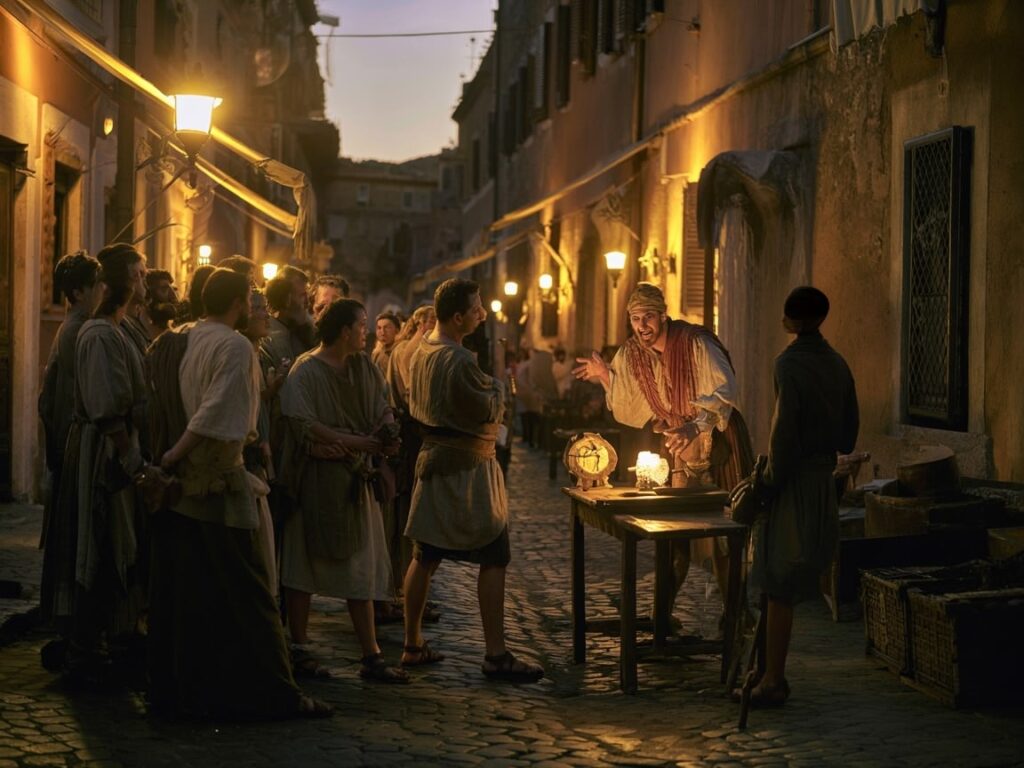
Conclusion
The summary of Roman nightlife culture reveals a vibrant tapestry woven from distinct yet interconnected elements: taverns, gambling, and urban legends. Each played a crucial role in crafting the unique character of ancient Rome after dark.
- Taverns served as social hubs where diverse classes mingled, sharing food, drink, and stories. These establishments were not just about leisure; they were also influenced by the broader trade and economy in Ancient Rome, which shaped the availability and variety of goods consumed.
- Gambling activities injected excitement and risk into the nocturnal scene, reflecting broader cultural attitudes toward chance and fortune.
- Urban legends added layers of mystery and intrigue, influencing how Romans perceived their city once the sun set.
This combination transformed Roman nights into more than just a time for rest—it became a dynamic space for social interaction, entertainment, and shared imagination. Roman Nightlife: Taverns, Gambling, and Urban Legends After Dark offers insight into how these aspects collectively shaped a distinctive urban atmosphere that resonates through history.
FAQs (Frequently Asked Questions)
What were the main types of taverns in ancient Roman nightlife and how did they differ?
In ancient Roman nightlife, taverns played a central role and included several types such as tabernae (shops), popinae (wine bars), cauponae (inns), and thermopolia (fast food counters). Each served distinct functions: tabernae were general shops, popinae specialized in serving wine, cauponae provided lodging for travelers, and thermopolia offered quick meals, contributing uniquely to the social fabric of Roman evenings.
How did Roman taverns influence social dynamics after dark?
Roman taverns were vibrant hubs where various social classes, including poorer citizens and travelers, interacted. These establishments fostered a lively atmosphere filled with entertainment, facilitating socializing across different groups. Taverns thus played a crucial role in shaping the nocturnal social scene of ancient Rome by providing spaces for communal engagement and leisure.
What types of gambling were popular in Roman nightlife settings?
Gambling was a prevalent activity within Roman nightlife, especially in tavern environments. Common games included dice throwing known as alea, alongside various betting customs that involved wagering on outcomes. These gambling practices not only provided entertainment but also reflected cultural attitudes toward risk-taking during nighttime social gatherings.
What role did urban legends play in the atmosphere of ancient Rome after dark?
Urban legends significantly shaped the nocturnal ambiance of Rome by infusing mystery and intrigue into nighttime social life. Stories involving ghosts and other mysterious events circulated among Romans after dark, enhancing the mystique of the city and influencing how people experienced their environment during evening hours.
How did the combination of taverns, gambling, and urban legends create a unique Roman nightlife culture?
The interplay of socializing in diverse tavern settings, engaging in gambling activities, and sharing urban legends created a dynamic urban environment after sunset. This combination fostered entertainment, risk-taking, and storytelling that collectively defined the distinctive character of ancient Rome’s nightlife culture.
Why is understanding Roman nightlife important for appreciating ancient Roman society?
Understanding Roman nightlife offers insights into the social behaviors, cultural values, and communal interactions beyond daytime activities. Elements like taverns, gambling practices, and urban folklore reveal how Romans relaxed, connected across classes, and navigated their urban environment after dark, providing a fuller picture of ancient Roman life.

